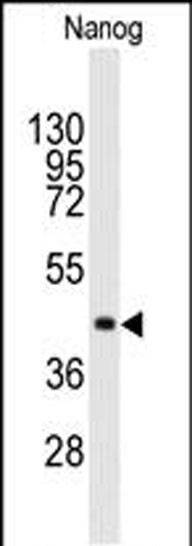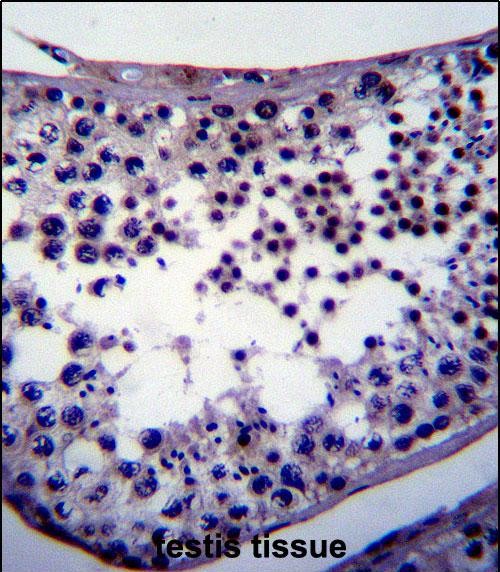
Mouse Anti-NANOG antibody
NANOG_MOUSE; Embryonic stem cell specific homeobox protein (Nanog); ENK; FLJ12581; FLJ40451; Homeobox transcription factor Nanog; Nanog homeobox; Homeobox protein NANOG; ES cell-associated protein 4; Early embryo specific expression NK-type homeobox prote
View History [Clear]
Details
Product Name NANOG Chinese Name 胚胎Stem cells关键蛋白单克隆抗体 Alias NANOG_MOUSE; Embryonic stem cell specific homeobox protein (Nanog); ENK; FLJ12581; FLJ40451; Homeobox transcription factor Nanog; Nanog homeobox; Homeobox protein NANOG; ES cell-associated protein 4; Early embryo specific expression NK-type homeobox protein; Homeobox transcription factor Nanog; Nanog; Ecat4. Research Area Tumour Signal transduction Stem cells Cyclin Cell Surface Molecule Cell differentiation Immunogen Species Mouse Clonality Monoclonal Clone NO. N3F1 React Species Human, Applications WB=1:500-2000 IHC-P=1:400-800 IHC-F=1:400-800 (Paraffin sections need antigen repair)
not yet tested in other applications.
optimal dilutions/concentrations should be determined by the end user.Theoretical molecular weight 36kDa Cellular localization The nucleus Form Liquid Concentration 1mg/ml immunogen Recombinant human NANOG. Lsotype IgG1,k Purification affinity purified by Protein G Buffer Solution 0.01M TBS(pH7.4) with 1% BSA, 0.03% Proclin300 and 50% Glycerol. Storage Shipped at 4℃. Store at -20 °C for one year. Avoid repeated freeze/thaw cycles. Attention This product as supplied is intended for research use only, not for use in human, therapeutic or diagnostic applications. PubMed PubMed Product Detail Nanog is a newly identified homeodomain-bearing transcriptional factor. Nanog expression is specific to early embryos and pluripotential stem cells including mouse and human embryonic stem (ES) and embryonic germ (EG) cells. It is a key molecule involved in the signaling pathway for maintaining the capacity for self-renewal and pluripotency, bypassing regulation by the STAT3 pathway. Nanog mRNA is present in pluripotent mouse and human cell lines, and absent from differentiated cells. Nanog-deficient ES cells lose pluripotency and differentiate into extraembryonic endoderm lineage. Thus it is one of the molecular markers suitable for recognizing the undifferentiated state of stem cells in the mouse and human.
NANOG is a new marker for testicular carcinoma in situ and germ cell tumors.
NANOG is a gene expressed in embryonic stem cells (ESCs) and is thought to be a key factor in maintaining pluripotency. NANOG thought to function in concert with other factors such as POU5F1 and SOX2 to establish ESC identity. These cells offer an important area of study because of their ability to maintain pluripotency. In other words, these cells have the ability to become virtually any cell of any of the three germ layers (endoderm, ectoderm, mesoderm).
Function:
Transcription regulator involved in inner cell mass and embryonic stem (ES) cells proliferation and self-renewal. Imposes pluripotency on ES cells and prevents their differentiation towards extraembryonic endoderm and trophectoderm lineages. Blocks bone morphogenetic protein-induced mesoderm differentiation of ES cells by physically interacting with SMAD1 and interfering with the recruitment of coactivators to the active SMAD transcriptional complexes. Acts as a transcriptional activator or repressor. Binds optimally to the DNA consensus sequence 5'-TAAT[GT][GT]-3' or 5'-[CG][GA][CG]C[GC]ATTAN[GC]-3'. When overexpressed, promotes cells to enter into S phase and proliferation.
Subunit:
Covalently attached to a number of proteins (By similarity). Interacts with USP25 (via ts SIM domain); the interaction sumoylates USP25 and inhibits its ubiquitin hydrolyzing activity. Interacts with SAE2 and UBE2I.
Subcellular Location:
Nucleus.
Tissue Specificity:
Expressed in testicular carcinoma and derived germ cell tumors (at protein level). Expressed in fetal gonads, ovary and testis. Also expressed in ovary teratocarcinoma cell line and testicular embryonic carcinoma. Not expressed in many somatic organs and oocytes.
Similarity:
Belongs to the Nanog homeobox family.
Contains 1 homeobox DNA-binding domain.
SWISS:
Q80Z64
Gene ID:
79923
Database links:Entrez Gene: 79923 Human
SwissProt: Q9H9S0 Human
Product Picture
Lane 1: NANOG Recombinant protein
Primary:
Anti-NANOG (SLM-51459M) at 1/1000 dilution
Secondary: IRDye800CW Goat Anti-Mouse IgG at 1/20000 dilution
Predicted band size: 36 kD
Observed band size: 45 kD
Sample:
Lane 1: K562 (Human) Cell Lysate
Primary:
Anti-NANOG (SLM-51459M) at 1/1000 dilution
Secondary: IRDye800CW Goat Anti-Mouse IgG at 1/20000 dilution
Predicted band size: 36 kD
Observed band size: 36 kD
Paraformaldehyde-fixed, paraffin embedded (human testis); Antigen retrieval by boiling in sodium citrate buffer (pH6.0) for 15min; Block endogenous peroxidase by 3% hydrogen peroxide for 20 minutes; Blocking buffer (normal goat serum) at 37°C for 30min; Antibody incubation with (NANOG ) Monoclonal Antibody, Unconjugated (SLM-51459M) at 1:200 overnight at 4°C, followed by operating according to SP Kit(Mouse)(sp-0024) instructionsand DAB staining.
References (0)
No References
Bought notes(bought amounts latest0)
No one bought this product
User Comment(Total0User Comment Num)
- No comment





 +86 571 56623320
+86 571 56623320
 +86 18668110335
+86 18668110335

